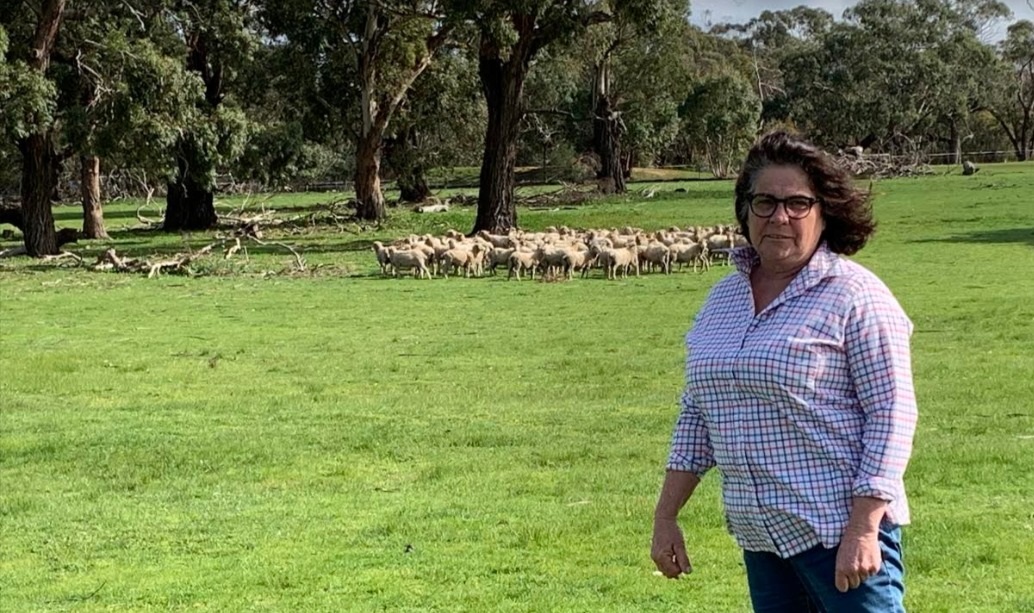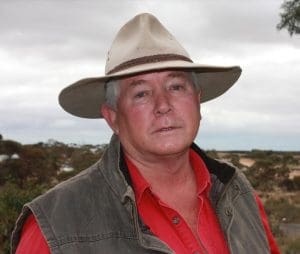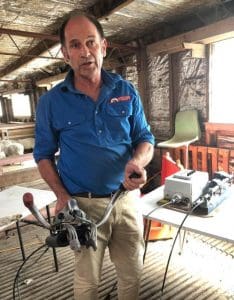
Victorian ultrafine wool grower Sherrie Cordie has alerted the industry to a potential change to the mulesing definition.
OPPOSITION is mounting this week to a proposed change “by stealth” of the definition of sheep mulesing in Victoria.
Under the Australian Animal Welfare Standards and Guidelines for Sheep, mulesing is the removal of skin from the breech and/or tail of a sheep using mulesing shears.
However, the proposed Prevention of Cruelty to Animals – Draft Regulations 2019, define mulesing as “mules means to remove skin from one or both of the breech and tail of a sheep.”
Submissions to the draft POCTA regulations close on September 23, but until last week the inclusion of the changed definition, which is supported by the RSPCA and other animal rights groups, had escaped the notice of the Victorian Farmers Federation, who helped draft the legislation.
Peak wool grower body WoolProducers Australia, the Victorian Farmers Federation and Victorian veterinarian John Steinfort, developer of the mulesing alternative, sheep freeze branding, all oppose any change to the current mulesing definition.

VFF Livestock president Leonard Vallance
VFF Livestock president Leonard Vallance said the federation was not consulted about the definition change and he would be discussing it with Agriculture Victoria and Minister for Agriculture Jaclyn Symes.
Mr Vallance said he wasn’t aware of the inclusion of the changed mulesing definition — “we just left it as surgical mulesing.”
Mr Vallance said the mulesing definition was discussed at Animal Welfare Victoria meetings, “but the assumption was that the language would be consistent.”
He would not support Victoria having a different mulesing definition to the rest of Australia and recognised the risk to research and development in this area.
“No, I wouldn’t, mulesing is mulesing and that’s the surgical removal of skin from the breech of a sheep with shears.
“That’s the accepted definition and that’s where it should be,’ he said.
“The important thing here is that the language is correct.”
However, a government spokesperson said the definition of mulesing has not changed since Animal Welfare Victoria consulted with the Victorian Farmers Federation.
“Animal Welfare Victoria will continue to consult with the Victorian Farmers Federation, and other stakeholders, on the proposed regulations to mandate the use of pain relief for mulesing in Victoria.”
“All feedback on the proposed regulations will be considered and amendments made where appropriate.”
Mulesing definition change ‘by stealth’ is atrocious – wool grower
Victorian ultrafine wool grower Sherrie Cordie alerted Sheep Central and the VFF to the proposed definition change and wanted to know “who has pushed to get this changed?”
She has not mulesed her 4000-sheep flock for about 10 years and is using clips as a mulesing alternative.
The proposed POCTA regulations have been supported by the VFF and WoolProducers Australia because they stipulate a person must not mules a sheep unless using a pain relief product registered for use on sheep by the Australian Pesticides and Veterinary Medicines Authority. However, Ms Cordie said apart from its mention in the proposed regulations’ definitions (page 4), there is no highlighting of the mulesing definition change in the overview or associated survey.
“Nowhere is it highlighted that the mulesing definition has been changed, unless you read all the regulations you wouldn’t know.
“It is changing the definition by stealth, it’s atrocious,” she said.
“I believe that wool producers should be urgently alerted to this anomaly and encouraged to have their say on the Engage Victoria website if they believe that the definition should be consistent.”
Ms Cordie believed the proposed definition change would mean clips and sheep freeze branding would be “dead in the water.”
“It would kill John Steinfort’s process and any other future research and development, it is just gone.
“Obviously the long-term solution is plainer breech sheep, but that is a decade away – what happens in between?”
She said sheep with wrinkly breeches are cut up to 20 times more than a breech modified (mulesed, clipped, liquid nitrogen or freeze branding) animal during this process.
“If this change is not made it will effectively encourage farmers to continue their mulesing practices (with pain relief) and not explore any more welfare-considerate options.”
Ms Cordie said the Australian Welfare Standards and Guidelines for sheep were developed (2016) to act as a guide for the development of new, nationally consistent policies to improve animal welfare arrangements in all Australian states and territories and provide guidance for all people responsible for sheep.
“This will not be the case if Victoria has a separate definition.”
WoolProducers Australia chief executive officer Jo Hall said the body will be making a submission into the POCTA Regulations process “and will strongly oppose any change to the mulesing definition as national consistency is essential”.
She said the current definition is recognised under the Animal Welfare Standards and Guidelines and the National Wool Declaration and has been in place for years.
“Any change would effectively be a changing of the goal posts which must not be allowed to occur.”
Definition change would wipe out mulesing alternatives

Dr John Steinfort with his sheep freeze branding applicator.
Mr Steinfort said the current mulesing definition should continue to apply in all Australian states and the proposed change in Victoria was a serious concern.
“This definition they are proposing at the moment would wipe out any potential alternatives and current alternatives that are in the industry that are proven in our own trials.”
He said University of Melbourne trials have proven that the impact on animals of sheep freeze branding was measured to be “nil or very little impact” and in lieu of a defined industry pathway for sheep breeders to cease mulesing, the use of freeze branding was a transitional pathway.
Mr Steinfort said he would be meeting with his local Member of Parliament to discuss making a submission to the Department Of Jobs, Precincts And Regions’ POCTA Regulations consultation process to oppose the definition change.
“The way these draft regulations were drawn up, it is either genetic non-mulesed or mulesed with pain relief, there is nothing in between.
“It boxes everybody into a corner.”
Mr Steinfort said Country Road and other Australian clothing brands have put a timeline on ceasing to use mulesed wool.
“So these draft regulations are just putting everyone into a box – so think of the reliance on the chemicals for flystrike and all the crutching and shearing with potential injury to the animal that is going to go on because of excess breech skin.”
RSPCA Australia has previously told Sheep Central it does not support any breech modification on sheep in the absence of a breeding program aimed at achieving a flystrike-resistant flock. The welfare body also believes that there is an “absolute need to conduct pain research” into the current liquid nitrogen or sheep freeze branding process, and this should be peer reviewed and published in a reputable journal.
RSPCA Australia also supports reviewing Australia’s definition of mulesing to bring it in line with the New Zealand, where the process has been banned. Under New Zealand’s Animal Welfare (Care and Procedures) Regulations 2018, a person must not, by any method, remove the breech, tail skin folds, or tail skin wrinkles of a sheep.
Sheep Central has contacted Victoria’s Minister for Agriculture Jaclyn Symes for comment.
Click here to read the proposed POCTA Regulations.
Click here for more details and to make a submission on the Engage Victoria website.

We used the clips for two years when they were first released and our wool was classified as mulsed by our wool brokers. For 20 odd years we have been culling any ewe lambs with a urine-stained breech. Combined with using plain-bodied rams, we have had no trouble with un-mulesed sheep in the last 13 years. Amazingly the plain ewes have more lambs and cut more wool.
We appear to be spectacularly poorly-served in recent years by wool industry leaders. One blunder follows another.,..
The mulseing issue won’t go away, and when industry leaders pull their heads out of the sand it will still be there.
There was a time before mulesing and there will be a time after mulesing. But the longer the issue remains, the more the image of wool is damaged.
It’s just a matter of how severe the damage is to the market for wool before the leaders face up to the demands of European and American consumers for mulesing to cease.
I agree the definition should not be changed to include non-invasive methods of skin reduction. The industry needs to embrace change and do all it can to recognise the benefits of wonderful new technology; not leave it in the same class as the old school barbaric actions such as mulesing. And I am currently the largest mulesing/marking contractor in the state of Victoria, so I’m not coming from an ‘activist’s’ perspective; rather someone who wants to see our industry thrive for years to come.
It doesn’t matter what you want to call it, it will always be the consumer — processors, spinners, manufacturers, salespeople and end-users — who decide whether it is mulesed or manipulated or whatever.
Get to work and fix your sheep and stop using excuses, as many have for more than 50 years.
I think the only sheep that should be called non-mulesed are the ones that have had no interference to the skin of the breech.
Get your heads out of the sand and breed a sheep that doesn’t need mulesing.
Hi Deane, thanks for your comments. Sheep farmers, ourselves included, have been aiming just for what you suggest. Here’s a link to some info you may find useful https://www.wool.com/on-farm-research-and-development/sheep-health-welfare-and-productivity/sheep-health/breech-flystrike/breech-genetics/
It is a fact that breeding a genetically-altered animal takes time and it’s this interim period, I’d say 10 years, that more humane alternatives need to address. A changed mulesing definition precludes these. For example, this year we were going to try the Metacam pain relief prior to marking, while using our usual clips instead of mulesing. This product would provide pain relief for all procedures – tail docking, ear tagging, castration and clip application. Depending on the outcome of the definition of mulesing, we will need to re-evaluate regarding the costs. Currently our non-mulesed wool brings a premium that we can then re-invest into our sheep welfare. Note that farmers who do not mules are generally more concerned about this. By precluding them from the premium and the resultant welfare spend they are being forced into mulesing with pain relief.
It’s Deane, actually. The link reflects an antiquated approach to plainness in sheep.
Attack the wrinkles with a vengence with breeding. If you lose a smidgen of clean fleece weight, so be it. You will well and truly make that up on fertility, survivability and the easy-care attributes of the new sheep. It shouldn’t take more than a generation to fix your sheep to not need mulesing or any of your intervention practises, that should be deemed as mulesing. Once you remove the skin, you are reducing the ability to class against the wrinkles.
Hi Deane, I agree with all that you’re saying, but it does take more than one generation to breed a wrinkle-free sheep. That’s just how dominant and recessive genes work unfortunately and sheep are two years old before joining.
You are correct that the AWI site and research is not up to scratch; however, there are farmers out there who for many years have been striving for the wrinkle-free sheep (see Donald’s comments below as a great example). Another great example is Noel Henderson’s Avington Merino stud. They ceased mulesing in 2011 after several years of breeding for wrinkle-free breeches… and no, I don’t have any connection to him or his stud. What a fantastic example to all wool growers of what can be achieved when you are forward-thinking and proactive. We need leaders like him to represent us in the industry.
Not all farmers support mulesing, not all farmers are mulesing and many farmers are transitioning, albeit with little or no support from industry leaders. These are the “silent achievers” who deserve accolades.
Deane, to move from a fairly heavy-skinned Riverina bloodline of 7-8 kg/hd, 19-20 micron and a 12 month shearing to plain-bodied sheep and not mulesing all lambs, took us about five years. Knowing what I know now, I could have done it in three generations — taking a bit of a hit to ewe numbers joined but made up with increased fertility. This was a good 15 years ago. Now, with so many more plain Merino bloodlines to choose from and better ASBV data, the process should be even quicker. Yes, there is a big change in the business model. We have a lot more lambs that grow to target weight faster (oh what a terrible problem to have) and also a six or eight monthly interval shearing for around the same annual wool cut or a bit less, depending on the chosen balance of wool/meat. A common misconception is to assume that the annual shearing costs are “double”. There is less wool to handle and the lines are generally simpler. The tallies are better, with a lower number of runs and less labour units/shearing. It’s irrelevant what the industry thinks is mulesing and what is not. That decision is down to the consumer.
“RSPCA Australia also supports reviewing Australia’s definition of mulesing to bring it in line with the New Zealand, where the process has been banned. Under New Zealand’s Animal Welfare (Care and Procedures) Regulations 2018, a person must not, by any method, remove the breech, tail skin folds, or tail skin wrinkles of a sheep.”
Does this mean New Zealand has also banned tailing?
It’s madness to suggest that the mulesing definition is only using shears. Under that logic, one could hack off breech skin with a blunt penknife and it would be considered “non-mulesed”. It does not get any dumber than this current argument.
Well Chick if you would have first declared that you are a co-founder of the company that developed Tri-Solfen perhaps your comments would have been more meaningful. I imagine that it would be in your interests to sell further pain relief products as opposed to actually working to cease mulesing in Australia.
So Sherrie, if you are using mulesing clips, do you declare your wool as non-mulesed or mulesed wool ?
Thanks Sherrie, it’s a very well known fact my connection to Tri-Solfen. In fact, I was elected to AWI with this achievement under my belt and you seem to also know this as well, so it has become a tedious monologue. Regardless, use of clips and or any other form of removing breech/tail skin is still mulesing. No matter how clever one tries to be with words. Having tried clips myself, they are equally painful/stressful to lambs and are a grossly inadequate welfare outcome for our sheep.
Dear Chick
I’m pleased that you are proud of your achievements…. as reported in the Qld Country Life in August: Chick Olsson: The man who helped save mulesing to once again stand for the AWI board…
How fortunate that Australian wool producers had on the AWI board two co-founders of Animal Ethics Pty Ltd (the developers of Tri-Solfen) when the decision was being made about continuing mulesing (2009-10). Sadly, the rest of the world and all the animal welfare organisations didn’t share your view of continuing mulesing with or without pain relief. And how wonderful that Animal Ethics Pty Ltd coincidentally had a product ready for the purpose.
Perhaps you aren’t aware of the research results of the clips? There was some excellent scientific trials conducted in 2011. I used the neutrophil:lymphocyte ratio results from these trials and compared them to the mulesing with pain relief results published on AWI website. The results demonstrated that the clips were far superior for lamb welfare than mulesing with pain relief. Good research is a better way to farm than the old… “I tried it once and in my opinion……”
Thanks Sherrie, wool growers voted for me overwhelmingly on three occasions, so I presume you support democratic processes. So, back to my question, do you use clips and claim NM status?